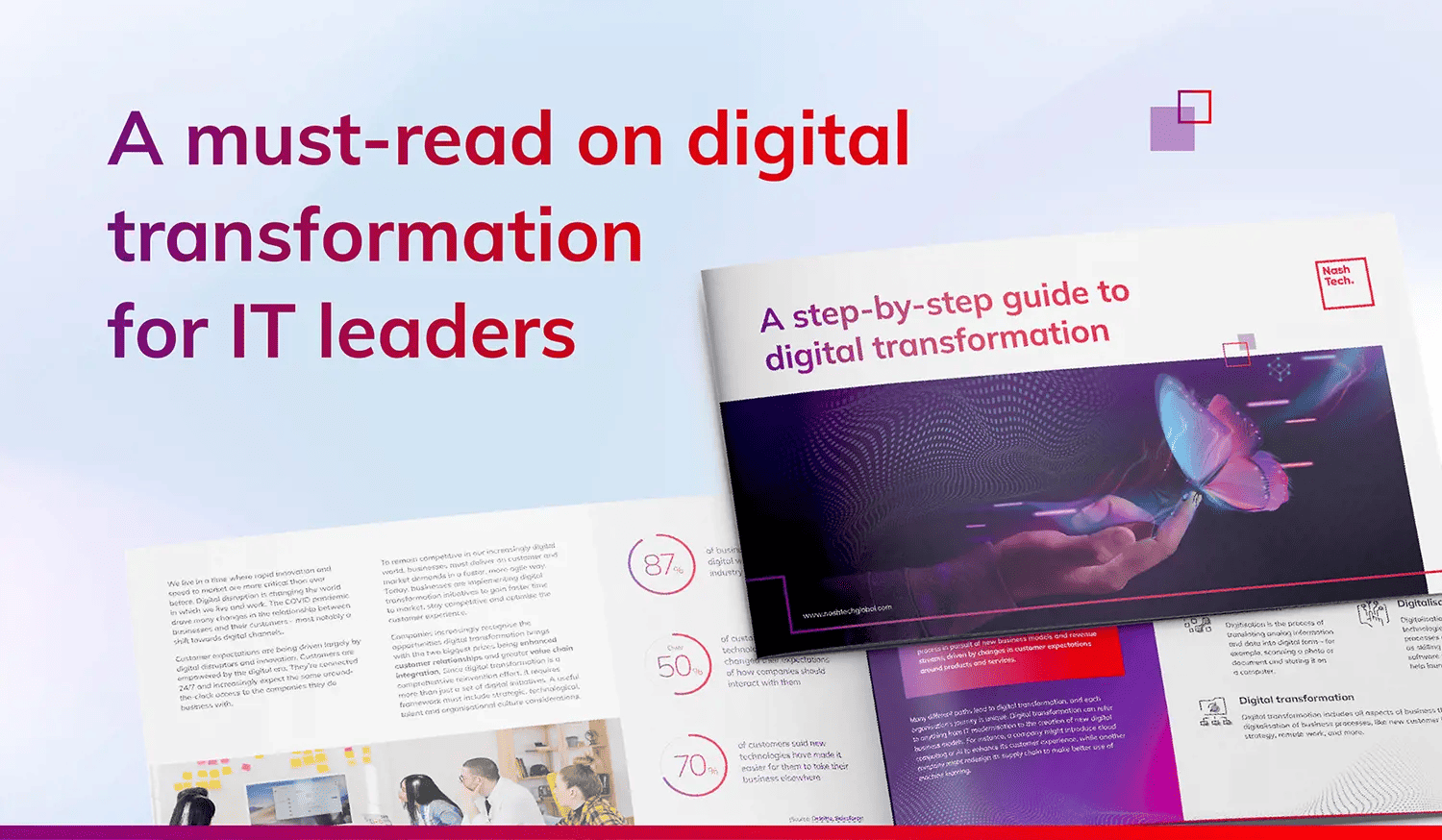Home / Our thinking / Insights / Security in the digital transformation age
Security in the digital transformation age

Table of contents
Two years ago, digital transformation kicked into high gear, with new processes and product development moving ahead at breakneck speed.
The push to digitalise was accelerated as companies rushed to meet consumer and employee needs. As IT and business leaders fast-tracked initiatives like agile and DevOps to improve speed to market, security considerations often took a backseat.
In many organisations’ haste to digitalise, they skipped a crucial step in the process…cybersecurity.
“Businesses around the world are moving very rapidly in this direction without fully understanding the security implications.“
Jim Tiller, CISO – Nash Squared
The Cybersecurity Risk in a Digital World
The pandemic forced digital tools to become the centre of our lives, which also brought an increase in the number of cyberattacks both in terms of volume and complexity. 82 percent of IT security and c-level respondents said they experienced at least one data breach due to digital transformation.
The proliferation of mobile devices, cloud computing, artificial intelligence, and IoT has created a new landscape of cyber risks. In particular, the shift to remote work and the increasing use of big data have made organisations and individuals more vulnerable to cyberattacks.
“Security is struggling with the evolution and rapid adoption of digital transformation. It’s up to business and IT Leaders to come up with frameworks and models that speak to digital transformation as an evolution, not an event.”
Jim Tiller, CISO – Nash Squared
With the advent of digital transformation, many organisations have become increasingly reliant on technology to operate. This has led to an increase in the number of cyberattacks as bad actors seek to take advantage of vulnerabilities in digital systems.
Reliable and resilient digital transformation can only be achieved when it has a foundation of cybersecurity beneath it. By sidestepping cybersecurity in their rush to digitalise, organisations, their employees, and their customers are left exposed.
Cybersecurity Priorities for Digital Transformation
Cybersecurity has become an essential part of our increasingly technological and digital world.
The rapidly changing digital world needs security teams and systems that can adapt to and prepare for unexpected shifts in the landscape.
In order to drive successful transformation, organisations must focus on secure digital transformation priorities that take into account all security concerns, not just the big ones.
Below are four key priorities organisations should consider:
- Develop a digital risk strategy. The risks to organisations of becoming digital are unique and based on the current state of business processes, people, and technology. To be successful, organisations must understand the risks it brings and manage them proactively. Managing risk in digital transformation is a continuous process. Establishing a digital risk framework will become increasingly important. Creating this framework requires alignment and support across the business. “We have to reincorporate the conversation of risk management back into the corporate world, back into the flow of how we operate as companies. We’re just too focused on technology. We have to get better at having risk conversations,” said Tiller.
- Make Identity and Access Management (IAM) a critical capability. IAM is a fundamental and critical cybersecurity capability. As digital activities evolve, the need for identity and access management has become increasingly prominent. “It comes down to identity and access management. It always does. So the biggest risk moving forward is dealing with who has rights and access to what, and in cloud and hybrid environments, it becomes exceedingly difficult to enforce. That’s where the gaps are occurring,” said Tiller. Without a robust IAM strategy, organisations open themselves up to cyber attacks as bad actors impersonate privileged users, and the costs can be devastating. The global average cost of a data breach is $4.35 million. Stolen or compromised credentials were not only the most common cause of a data breach in 2022 but at 327 days, took the longest time to identify. Identifying IAM stakeholders, developing access and identity strategies that aid business goals, and designing an IAM governance framework that works towards performance targets can help organisations remain resilient in the shifting technology landscape.
- Implement Zero Trust. Zero Trust is a security model based on the philosophy that no person or device should be granted access to an organisation’s network until their identity and authorization are verified. Implementing a zero trust framework in an organisation can reduce the risk of a cybersecurity incident by continuously authenticating users. While organisations have in recent years acknowledged zero trust as an effective method to combat cyberattacks, outdated legacy security infrastructure and the harsh nature of denying access to users have left organisations flat-footed. Research shows that organisations that have a mature zero trust strategy can save more than $1 million during a breach. To implement zero trust, IT leaders must establish c-suite buy-in, obtain endpoint visibility, segment the organisation’s network, and establish least privileged access.
- Cultivate a culture of safety. With the rise of sophisticated cyberattacks, security must be everyone’s job. Fostering a culture of security ensures that employees are aware of what the risks are, or could be, and understand how to respond to or report such risks. Organisations must set aside budget and resources for training their employees on all aspects related to cyber hygiene and create mock exercises to see how prepared their employees are with respect to identifying a cyber threat or potential security vulnerabilities. It’s crucial that employees understand why security is important and see themselves as part of the solution. As risk profiles change, so must an organisation’s safety culture.
Cybersecurity risks can have a devastating impact on businesses, from data breaches that leak customer information to ransomware attacks that lock down company files.
However, equipped with the latest knowledge and breakthrough cybersecurity technologies, business leaders can take the necessary steps to protect their organisations, strengthen resilience and stand out in a competitive digital economy.
Making the move into the digital world can be a significant change for any organisation. To learn more about the NashTech approach or arrange a call to discuss how we can help you in your digital transformation journey, email info@nashtechglobal.com.
To understand what steps you should be taking to transform your business and become the next digital disruptor, download our eBook.
Suggested articles

Driving transformation: Australia to be a world-leading digital economy by 2030
The Australian economy is estimated to be A$315 billion in the next decade owing to its latest shift towards digitisation.

Tackling App Modernisation Challenges in Australia
Tackling App Modernisation Challenges in Australia Australian companies are underway with the task of app modernisation, but it's not happening fast...

Assessing Your Organisation's Readiness for Digital Transformation
Digital transformation is not only changing companies, it's redefining markets and industries. Yet, when discussing digital transformation, we often...
